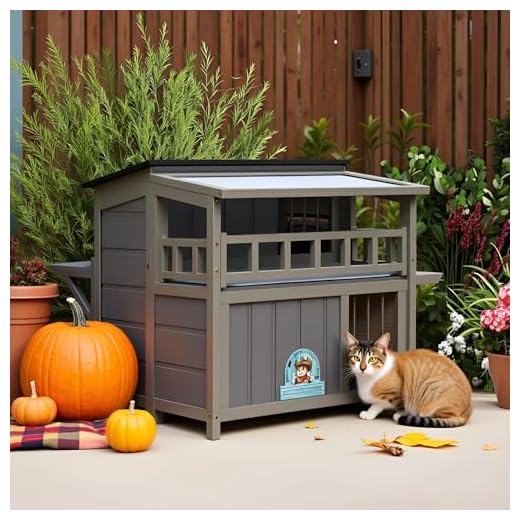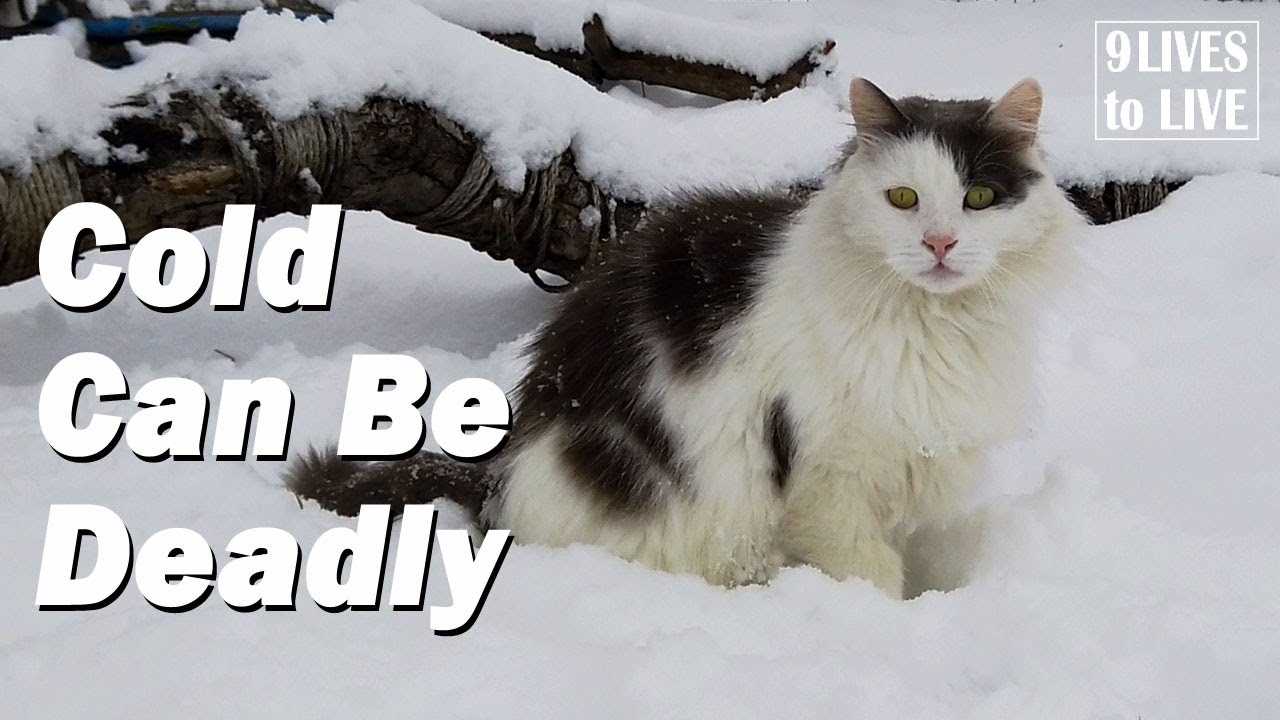



For those wondering about the ability of outdoor felines to thrive in frigid temperatures, the answer is yes, they can manage quite well under certain conditions. I’ve observed various strategies that help them maintain warmth and well-being when the mercury drops.
First, these resourceful creatures often seek shelter in hidden nooks, such as abandoned buildings or under decks, to shield themselves from harsh winds and snow. Providing insulated spaces, like straw-filled boxes, can significantly enhance their chances of staying warm during winter months.
Additionally, their thick fur acts as a natural insulator, allowing them to retain body heat. Regular grooming helps keep their coats in top shape, which is essential for warmth. It’s also beneficial to ensure access to fresh water, as icy conditions can make hydration challenging.
Food sources are critical during this time. High-calorie diets assist in generating body heat, so offering a bit more kibble or wet food can be advantageous. Monitoring their health for signs of frostbite or hypothermia is equally important, as early detection can prevent severe issues.
Can Feral Cats Survive in the Cold
When temperatures drop, outdoor felines display impressive resilience. They adapt by growing thicker fur, which provides insulation against chilly conditions. Some even develop a layer of fat that aids in warmth retention.
Finding shelter is vital. Stray felines often seek out garages, sheds, or other protected spaces where they can escape harsh winds and precipitation. Building shelters using insulated materials can significantly enhance their chances of staying warm.
Food sources become crucial during frigid months. Providing consistent nourishment helps maintain their energy levels. Dry kibble is preferable, as it won’t freeze, and adding wet food occasionally can increase hydration.
Observing their behavior offers insights into their adaptation strategies. Often, they form small groups for warmth, huddling together to share body heat. This social behavior is a natural instinct that improves survival odds.
Monitoring local populations is essential. If you notice a group struggling in extreme weather, consider organizing a feeding station or shelter initiative. Every bit of assistance counts in ensuring their well-being during harsh conditions.
Understanding Feral Cat Physiology and Cold Weather Adaptations

To thrive in chilly environments, these resilient creatures possess unique physiological traits. Thick fur coats offer significant insulation, helping maintain body warmth. Additionally, their body fat reserves provide extra energy during harsh winters.
Physical Adaptations
- Insulating Fur: A double-layered coat traps air, providing warmth. A dense undercoat develops during colder months.
- Fat Storage: They accumulate fat before winter, creating an energy reserve crucial for survival.
- Low Metabolic Rate: During extreme temperatures, their metabolism slows, conserving energy.
Behavioral Strategies
- Seeking Shelter: They instinctively look for warm places, such as abandoned buildings or dense vegetation.
- Group Living: Socializing in groups helps share body heat and offers protection from elements.
- Huddling: Curling up in tight spaces minimizes heat loss.
Understanding their adaptations can guide efforts to support these animals in winter. For example, providing safe shelters can enhance their chances. Also, consider the safety of plants around them, like are chamomile flowers safe for cats, to ensure their well-being.
Assessing Shelter Needs for Feral Cats in Cold Climates
Providing adequate protection is critical for outdoor felines during frigid months. Structures must be insulated, elevated off the ground, and waterproof to ensure warmth and dryness. A minimum size of 24 inches long, 18 inches wide, and 18 inches high is recommended for each shelter, allowing enough space for movement while retaining body heat.
Insulation materials such as straw or foam board are optimal. Straw is preferred over blankets or hay, as it resists moisture better and retains warmth. Use reflective materials inside to help bounce heat back into the shelter. Ensure that the entrance is small enough to prevent wind but large enough for easy access.
Multiple shelters in a location can help create a community space. Grouping several units together allows for shared warmth among individuals. Each shelter should be spaced adequately to prevent overcrowding and promote comfort.
Regular checks are necessary to maintain these structures. Inspect for damage, moisture, and the presence of pests. Replenishing bedding material periodically ensures a safe and inviting environment. Consider using heated pads for extra warmth, but ensure they are safe and designed for outdoor use.
Location matters. Place shelters in windbreaks or near natural barriers. Avoid areas with heavy foot traffic or where they may be disturbed by humans or other animals. Ensuring that these shelters are discreet yet accessible is crucial for their safety and comfort.
Feeding Strategies to Support Feral Cats During Winter Months
Providing adequate nutrition is crucial for outdoor felines facing chilly temperatures. One practical approach is to increase the calorie density of their meals. Offering high-quality wet food can help maintain body temperature, as it contains more moisture and fat compared to dry kibble.
Establishing Feeding Stations
Setting up designated feeding spots can streamline the process of providing sustenance. Choose a location that is sheltered from harsh winds and easily accessible. Use insulated containers to keep food from freezing, and consider automatic feeders to ensure a consistent supply, especially during extreme weather.
Timing and Frequency

Adjust feeding times to align with the colder parts of the day. Providing meals in the late afternoon or early evening can help them stock up on energy before nighttime temperatures drop. Frequent, smaller meals throughout the day will also support their energy levels and help them cope better with the elements.
In addition to food, ensuring fresh water is available is vital. Use heated water bowls to prevent freezing, allowing them to stay hydrated. For those interested in enhancing their outdoor access, exploring options like the best pet door for cats can create a safe entry point for shelter and food access.
For those wondering about the ability of outdoor felines to thrive in frigid temperatures, the answer is yes, they can manage quite well under certain conditions. I’ve observed various strategies that help them maintain warmth and well-being when the mercury drops.
First, these resourceful creatures often seek shelter in hidden nooks, such as abandoned buildings or under decks, to shield themselves from harsh winds and snow. Providing insulated spaces, like straw-filled boxes, can significantly enhance their chances of staying warm during winter months.
Additionally, their thick fur acts as a natural insulator, allowing them to retain body heat. Regular grooming helps keep their coats in top shape, which is essential for warmth. It’s also beneficial to ensure access to fresh water, as icy conditions can make hydration challenging.
Food sources are critical during this time. High-calorie diets assist in generating body heat, so offering a bit more kibble or wet food can be advantageous. Monitoring their health for signs of frostbite or hypothermia is equally important, as early detection can prevent severe issues.
Can Feral Cats Survive in the Cold
When temperatures drop, outdoor felines display impressive resilience. They adapt by growing thicker fur, which provides insulation against chilly conditions. Some even develop a layer of fat that aids in warmth retention.
Finding shelter is vital. Stray felines often seek out garages, sheds, or other protected spaces where they can escape harsh winds and precipitation. Building shelters using insulated materials can significantly enhance their chances of staying warm.
Food sources become crucial during frigid months. Providing consistent nourishment helps maintain their energy levels. Dry kibble is preferable, as it won’t freeze, and adding wet food occasionally can increase hydration.
Observing their behavior offers insights into their adaptation strategies. Often, they form small groups for warmth, huddling together to share body heat. This social behavior is a natural instinct that improves survival odds.
Monitoring local populations is essential. If you notice a group struggling in extreme weather, consider organizing a feeding station or shelter initiative. Every bit of assistance counts in ensuring their well-being during harsh conditions.
Understanding Feral Cat Physiology and Cold Weather Adaptations

To thrive in chilly environments, these resilient creatures possess unique physiological traits. Thick fur coats offer significant insulation, helping maintain body warmth. Additionally, their body fat reserves provide extra energy during harsh winters.
Physical Adaptations
- Insulating Fur: A double-layered coat traps air, providing warmth. A dense undercoat develops during colder months.
- Fat Storage: They accumulate fat before winter, creating an energy reserve crucial for survival.
- Low Metabolic Rate: During extreme temperatures, their metabolism slows, conserving energy.
Behavioral Strategies
- Seeking Shelter: They instinctively look for warm places, such as abandoned buildings or dense vegetation.
- Group Living: Socializing in groups helps share body heat and offers protection from elements.
- Huddling: Curling up in tight spaces minimizes heat loss.
Understanding their adaptations can guide efforts to support these animals in winter. For example, providing safe shelters can enhance their chances. Also, consider the safety of plants around them, like are chamomile flowers safe for cats, to ensure their well-being.
Assessing Shelter Needs for Feral Cats in Cold Climates
Providing adequate protection is critical for outdoor felines during frigid months. Structures must be insulated, elevated off the ground, and waterproof to ensure warmth and dryness. A minimum size of 24 inches long, 18 inches wide, and 18 inches high is recommended for each shelter, allowing enough space for movement while retaining body heat.
Insulation materials such as straw or foam board are optimal. Straw is preferred over blankets or hay, as it resists moisture better and retains warmth. Use reflective materials inside to help bounce heat back into the shelter. Ensure that the entrance is small enough to prevent wind but large enough for easy access.
Multiple shelters in a location can help create a community space. Grouping several units together allows for shared warmth among individuals. Each shelter should be spaced adequately to prevent overcrowding and promote comfort.
Regular checks are necessary to maintain these structures. Inspect for damage, moisture, and the presence of pests. Replenishing bedding material periodically ensures a safe and inviting environment. Consider using heated pads for extra warmth, but ensure they are safe and designed for outdoor use.
Location matters. Place shelters in windbreaks or near natural barriers. Avoid areas with heavy foot traffic or where they may be disturbed by humans or other animals. Ensuring that these shelters are discreet yet accessible is crucial for their safety and comfort.
Feeding Strategies to Support Feral Cats During Winter Months
Providing adequate nutrition is crucial for outdoor felines facing chilly temperatures. One practical approach is to increase the calorie density of their meals. Offering high-quality wet food can help maintain body temperature, as it contains more moisture and fat compared to dry kibble.
Establishing Feeding Stations
Setting up designated feeding spots can streamline the process of providing sustenance. Choose a location that is sheltered from harsh winds and easily accessible. Use insulated containers to keep food from freezing, and consider automatic feeders to ensure a consistent supply, especially during extreme weather.
Timing and Frequency

Adjust feeding times to align with the colder parts of the day. Providing meals in the late afternoon or early evening can help them stock up on energy before nighttime temperatures drop. Frequent, smaller meals throughout the day will also support their energy levels and help them cope better with the elements.
In addition to food, ensuring fresh water is available is vital. Use heated water bowls to prevent freezing, allowing them to stay hydrated. For those interested in enhancing their outdoor access, exploring options like the best pet door for cats can create a safe entry point for shelter and food access.
For those wondering about the ability of outdoor felines to thrive in frigid temperatures, the answer is yes, they can manage quite well under certain conditions. I’ve observed various strategies that help them maintain warmth and well-being when the mercury drops.
First, these resourceful creatures often seek shelter in hidden nooks, such as abandoned buildings or under decks, to shield themselves from harsh winds and snow. Providing insulated spaces, like straw-filled boxes, can significantly enhance their chances of staying warm during winter months.
Additionally, their thick fur acts as a natural insulator, allowing them to retain body heat. Regular grooming helps keep their coats in top shape, which is essential for warmth. It’s also beneficial to ensure access to fresh water, as icy conditions can make hydration challenging.
Food sources are critical during this time. High-calorie diets assist in generating body heat, so offering a bit more kibble or wet food can be advantageous. Monitoring their health for signs of frostbite or hypothermia is equally important, as early detection can prevent severe issues.
Can Feral Cats Survive in the Cold
When temperatures drop, outdoor felines display impressive resilience. They adapt by growing thicker fur, which provides insulation against chilly conditions. Some even develop a layer of fat that aids in warmth retention.
Finding shelter is vital. Stray felines often seek out garages, sheds, or other protected spaces where they can escape harsh winds and precipitation. Building shelters using insulated materials can significantly enhance their chances of staying warm.
Food sources become crucial during frigid months. Providing consistent nourishment helps maintain their energy levels. Dry kibble is preferable, as it won’t freeze, and adding wet food occasionally can increase hydration.
Observing their behavior offers insights into their adaptation strategies. Often, they form small groups for warmth, huddling together to share body heat. This social behavior is a natural instinct that improves survival odds.
Monitoring local populations is essential. If you notice a group struggling in extreme weather, consider organizing a feeding station or shelter initiative. Every bit of assistance counts in ensuring their well-being during harsh conditions.
Understanding Feral Cat Physiology and Cold Weather Adaptations

To thrive in chilly environments, these resilient creatures possess unique physiological traits. Thick fur coats offer significant insulation, helping maintain body warmth. Additionally, their body fat reserves provide extra energy during harsh winters.
Physical Adaptations
- Insulating Fur: A double-layered coat traps air, providing warmth. A dense undercoat develops during colder months.
- Fat Storage: They accumulate fat before winter, creating an energy reserve crucial for survival.
- Low Metabolic Rate: During extreme temperatures, their metabolism slows, conserving energy.
Behavioral Strategies
- Seeking Shelter: They instinctively look for warm places, such as abandoned buildings or dense vegetation.
- Group Living: Socializing in groups helps share body heat and offers protection from elements.
- Huddling: Curling up in tight spaces minimizes heat loss.
Understanding their adaptations can guide efforts to support these animals in winter. For example, providing safe shelters can enhance their chances. Also, consider the safety of plants around them, like are chamomile flowers safe for cats, to ensure their well-being.
Assessing Shelter Needs for Feral Cats in Cold Climates
Providing adequate protection is critical for outdoor felines during frigid months. Structures must be insulated, elevated off the ground, and waterproof to ensure warmth and dryness. A minimum size of 24 inches long, 18 inches wide, and 18 inches high is recommended for each shelter, allowing enough space for movement while retaining body heat.
Insulation materials such as straw or foam board are optimal. Straw is preferred over blankets or hay, as it resists moisture better and retains warmth. Use reflective materials inside to help bounce heat back into the shelter. Ensure that the entrance is small enough to prevent wind but large enough for easy access.
Multiple shelters in a location can help create a community space. Grouping several units together allows for shared warmth among individuals. Each shelter should be spaced adequately to prevent overcrowding and promote comfort.
Regular checks are necessary to maintain these structures. Inspect for damage, moisture, and the presence of pests. Replenishing bedding material periodically ensures a safe and inviting environment. Consider using heated pads for extra warmth, but ensure they are safe and designed for outdoor use.
Location matters. Place shelters in windbreaks or near natural barriers. Avoid areas with heavy foot traffic or where they may be disturbed by humans or other animals. Ensuring that these shelters are discreet yet accessible is crucial for their safety and comfort.
Feeding Strategies to Support Feral Cats During Winter Months
Providing adequate nutrition is crucial for outdoor felines facing chilly temperatures. One practical approach is to increase the calorie density of their meals. Offering high-quality wet food can help maintain body temperature, as it contains more moisture and fat compared to dry kibble.
Establishing Feeding Stations
Setting up designated feeding spots can streamline the process of providing sustenance. Choose a location that is sheltered from harsh winds and easily accessible. Use insulated containers to keep food from freezing, and consider automatic feeders to ensure a consistent supply, especially during extreme weather.
Timing and Frequency

Adjust feeding times to align with the colder parts of the day. Providing meals in the late afternoon or early evening can help them stock up on energy before nighttime temperatures drop. Frequent, smaller meals throughout the day will also support their energy levels and help them cope better with the elements.
In addition to food, ensuring fresh water is available is vital. Use heated water bowls to prevent freezing, allowing them to stay hydrated. For those interested in enhancing their outdoor access, exploring options like the best pet door for cats can create a safe entry point for shelter and food access.









